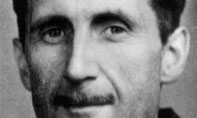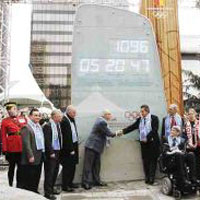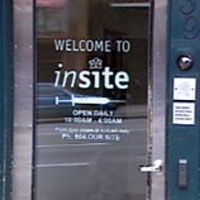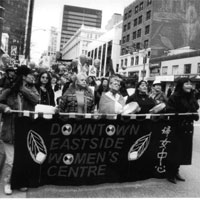- About Us
- Columns
- Letters
- Cartoons
- The Udder Limits
- Archives
- Ezy Reading Archive
- 2024 Cud Archives
- 2023 Cud Archives
- 2022 Cud Archives
- 2021 Cud Archives
- 2020 Cud Archives
- 2015-2019
- 2010-2014
- 2004-2009
 |
Down and Out in Vancouver (Living on the streets of the World’s most livable city) |
"I never met anyone who wanted to be here," she said. "If they had the means and the opportunity to get out, they would."
(Maggy Gisle, who spent 16 years living on the streets of Vancouver, quoted in The Globe and Mail, 15 February 2007)
Before the fame of Animal Farm and Nineteen Eighty-Four, George Orwell lived in poverty for several years in the late 1920’s and early 1930’s. Those experiences in his own late twenties (Orwell was born Eric Arthur Blair in 1903) led Orwell to write the memoir Down and Out in Paris and London, published when aged thirty in 1933. Reading Down and Out in Paris and London shortly after my own thirtieth birthday in Vancouver, it became apparent that Orwell’s memoir had all the insight and relevance of his better-known works of political fiction and allegory.
Personally, I have been not-so-down-and-out in Vancouver, living in a city since the middle of last year that is often recognised as the world’s most livable, in the company of Melbourne and Zurich (http://www.cnn.com/2005/WORLD/europe/10/04/eui.survey/index.html). However the working hours that support my easy days in this city, have by chance, drawn me to Vancouver’s oldest neighbourhood, and the streets of the “Downtown Eastside.” This uniform grid of gritty streets centred around the intersection of Hastings and Main Streets, and now nestled under the shadow of the sky-scraping commercial district is the historical heart of Vancouver, having once been home to City Hall, the courthouse and the scene of prosperous commerce. Sadly now, that intersection of Hastings and Main is often referred to as “Wastings and Pain” - as the recent decades have seen a decline in fortunes for this once vibrant centre of British Columbia, now home to Vancouver’s homelessness, prostitution and drug trade. During the 1980’s and 90’s the iconic Canadian department stores of Eatons and Woodwards moved out of the area, to be replaced by the darker commerce of sex and drugs, and leaving only cheap accommodation, darkened bars, pawn shops, eclectic convenience stores and an ailing Chinatown.
 Adding to the influx of the desperate was the on-going closure of mental institutions in Vancouver – the most famous being “Riverview” which housed more than 4,000 patients in the 1960’s. The stately (and supposedly haunted) buildings now have beds for only a few hundred, and in large part stands as a backdrop for Vancouver’s blossoming entertainment industry, having hosted scenes from the X-Files and American Gothic (perhaps also the scene of more accepted celebrity drug taking). (In 1998, the provincial government ordered Riverview hospital to close all its beds by 2007 and transfer patients to regional health authorities.)
Adding to the influx of the desperate was the on-going closure of mental institutions in Vancouver – the most famous being “Riverview” which housed more than 4,000 patients in the 1960’s. The stately (and supposedly haunted) buildings now have beds for only a few hundred, and in large part stands as a backdrop for Vancouver’s blossoming entertainment industry, having hosted scenes from the X-Files and American Gothic (perhaps also the scene of more accepted celebrity drug taking). (In 1998, the provincial government ordered Riverview hospital to close all its beds by 2007 and transfer patients to regional health authorities.)
As Vancouver grew into an international city with Expo ’86, and now as host of the 2010 Winter Olympics, refuge for those who didn’t fit into this glorious city was to be found in the Downtown Eastside. And there they have remained, up to the recent months when I have wandered naively into the scene of poverty, substance abuse and despair.
A private school boy in the middle class bureaucratic comfort of Australia’s capital city has little exposure to homelessness. When I was 18 and having just moved to the United Kingdom (rights of passage for so many), I spent much of my first weeks handing out what few pounds I had to every beggar on Oxford’s High Street – unused to such social need and desperate pleas for help. With time, that practice faded and in recent years, having traveled through the rural poverty of subsistence living in South America and Africa, my sense of charity towards the urban disaffected of the developed world had hardened.
But within a week of working in a law office in the Downtown Eastside of Vancouver (or more accurately one of its precincts – Gastown), I’d been stunned by the hopeless, drug induced frenzy of the hundreds (thousands) of Canadians living on the streets in this area of such a beautiful city. After some days of charitable offerings, I offered a particularly wild-eyed addict a ‘loonie’ (Canadian for a $1 coin), however when he asked for the $5 note that he had spied in my wallet instead, sadly my cynicism returned. (In recent days I saw that same figure receive a coffee and a muffin from my favourite café in Gastown, only for him to lament “So, I suppose you don’t have any money, then?”) So, for a few months I returned to an apologetic refusal and the categorical condemnation that is so easy to apply, in the face of individual cries for help. Perhaps many who have lived in this city longer than I, have done the same over the years towards their hopeless brethren.
Gradually in the New Year though, events in Vancouver have transpired to make the ‘not-so-down-and-out’ wonder again about those who live on their streets. Grey, sunken faces, bowed behind the cardboard pleas for work; the bearded man in his sixties on his knees begging with tears in his eyes, having received nothing in response to his outstretched cap; the wild, hopeless, contorted, animal-like figures of junkies, the edgy cherubic street workers – Orwell’s characters lost in time eighty years on in the icy grip of a northern winter.
Not that the wonder is anything new: the Downtown Eastside has long been labeled with the unfortunate distinction of having the highest rate of HIV infection in the Western world. And not that the wonder has gone unattended until now either, as North America’s first safe injection site – Insite – was opened in the heart of the area in 2004, and receives an average of 600 visits per day. (There is suggestion that the Conservative Federal Government may discontinue Insite’s operations, as it has deferred its decision on its operations its until December 31, 2007.)
Perhaps my reflective view was aroused having so recently been moved by the empathy of Orwell’s writing. But in recent weeks, every citizen in Vancouver has been moved and responded in some way to the criminal trial of Robert “Willie” Pickton, currently charged with the murder of six prostitutes, but potentially responsible for the death of up to fifty women from the Downtown Eastside. The trial has made international headlines, with sickening details that the media gorges on, in much the same way that Pickton’s pigs are said to have dealt with the remains of his victims. But behind the embarrassment for a city that is priming itself to host the 2010 Winter Olympics, the trial, and its victims have focused attention sharply on the plight of its fringe-dwellers in the Downtown Eastside.
 Vancouver’s worlds collided on Tuesday 13 February when Vancouver police arrested seven anti-poverty activists protesting at the opening of a ceremonial Omega clock that is counting down to the opening of the Winter Olympics. The incident was widely reported, prompting headlines such as “Olympic clock ticks off protesters” (in the Toronto based national paper The Globe and Mail), however it was the beginning of a week of articles that suggest that as the countdown to the Olympics and the Pickton verdict intensifies, so too will the attention given to the streets of “Wasting and Pain.” (Apparently the idea of the clock was borrowed from Tiananmen Square’s Olympic timepiece, so as an aside, it makes you wonder what is happening to the homeless on the streets of Beijing in preparation for its summer Olympics next year.)
Vancouver’s worlds collided on Tuesday 13 February when Vancouver police arrested seven anti-poverty activists protesting at the opening of a ceremonial Omega clock that is counting down to the opening of the Winter Olympics. The incident was widely reported, prompting headlines such as “Olympic clock ticks off protesters” (in the Toronto based national paper The Globe and Mail), however it was the beginning of a week of articles that suggest that as the countdown to the Olympics and the Pickton verdict intensifies, so too will the attention given to the streets of “Wasting and Pain.” (Apparently the idea of the clock was borrowed from Tiananmen Square’s Olympic timepiece, so as an aside, it makes you wonder what is happening to the homeless on the streets of Beijing in preparation for its summer Olympics next year.)
The following day, BBC Online carried an article “Vancouver's 'dirty little secret'” (by Heather Alexander - http://news.bbc.co.uk/2/hi/americas/6355285.stm,Wednesday 14 February 2007) as part of its wider coverage of the Pickton trial. Reflecting on the anonymity of the victims in such a faceless neighbourhood, devoid of identity, the article stated:
“When officers did start investigating - over a decade after the first women disappeared - they admitted they were baffled. In 1999, one constable told local channel Citynews: "In the case of the missing women, we don't have a suspect. In fact we don't have a crime." … Two years later they said: "We don't have any leads like crime scenes to help us uncover more facts."
Again on the Thursday, the national paper The Globe and Mail ran a front-page article about a poignant Valentines Day procession through the raining Vancouver streets, in memory of missing or dead Vancouver women. Journalist Stephanie Levitz reflected that:
“ …though the spectre of the [Pickton] trial loomed over the 16th annual Missing Women's Memorial March, it was the perceived indifference of people to the plight of the missing women and the fate of those still on the streets that hung heavy in the sage-filled air.”
 One of those marching was Maggy Gisle (quoted in opening) who spent 16 years living on the streets of Vancouver, and stated plainly that:
One of those marching was Maggy Gisle (quoted in opening) who spent 16 years living on the streets of Vancouver, and stated plainly that:
“Nobody wakes up one morning and decides to be a drug-addict or sell sex to feed their habit.”
Perhaps that’s the reality of a sad situation that I should have heard long ago. Perhaps Pickton’s trial is a proceeding that should have occurred long ago. But more than both of those, perhaps Down and Out in Paris and London was a book that I should have read long ago. The final words of Orwell’s memoir are:
“I shall never again think that all tramps are drunken scoundrels, nor expect a beggar to be grateful when I give him a penny, nor be surprised if men out of work lack energy, nor subscribe to the Salvation Army, nor pawn my clothes, nor refuse a handbill, nor enjoy a meal at a smart restaurant. That is a beginning.”
Perhaps there is a new beginning for the Downtown Eastside, for those on the streets and for those like me, (and the thousands of Olympic tourists in a few years’ time) who just pass through it.
